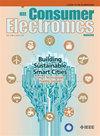Quantum Communication for Video Transmission Over Error-Prone Channels
IF 4.3
2区 计算机科学
Q1 ENGINEERING, ELECTRICAL & ELECTRONIC
引用次数: 0
Abstract
Quantum communication offers transformative potential for media transmission by addressing the limitations of classical communication systems. To realize this potential, the study proposes a quantum communication framework for transmitting compressed videos over error-prone channels, leveraging quantum superposition. Two channel coding schemes are analyzed: quantum error correction (three-qubit, five-qubit, and seven-qubit codes) and classical error correction (1/3 rate polar code), all operating within the same bandwidth constraints. The proposed systems are benchmarked against a classical communication system using 1/3 rate polar codes. Results show that the three-qubit error correction-based quantum communication system, while simple and efficient, achieves significant performance gains over both classical error correction-based quantum and classical communication systems, with up to 41.42 dB in peak signal-to-noise ratio (PSNR), 0.9639 in structural similarity index measure (SSIM), and 94.4042 in video multimethod assessment fusion (VMAF). However, the five-qubit and seven-qubit systems outperform the three-qubit system, with the seven-qubit system surpassing all others in high noise environments, demonstrating its robustness across various group of pictures (GOP) formats. These findings highlight the trade-offs between simplicity and complexity, as the three-qubit system is practical and efficient, while the five-qubit and seven-qubit channel codes offer higher fidelity and resilience at the cost of increased complexity.易出错通道上视频传输的量子通信
量子通信通过解决经典通信系统的局限性,为媒体传输提供了变革性的潜力。为了实现这一潜力,该研究提出了一种量子通信框架,用于在容易出错的信道上传输压缩视频,利用量子叠加。分析了两种信道编码方案:量子纠错(三量子比特、五量子比特和七量子比特码)和经典纠错(1/3速率极化码),它们都在相同的带宽约束下工作。所提出的系统与使用1/3速率极性码的经典通信系统进行了基准测试。结果表明,基于三量子位纠错的量子通信系统在简单高效的同时,比经典纠错量子通信系统和经典通信系统都取得了显著的性能提升,峰值信噪比(PSNR)达到41.42 dB,结构相似指数(SSIM)达到0.9639 dB,视频多方法评估融合(VMAF)达到94.4042 dB。然而,五量子位和七量子位系统优于三量子位系统,七量子位系统在高噪声环境中超越了所有其他系统,证明了其在各种图片组(GOP)格式中的鲁棒性。这些发现强调了简单性和复杂性之间的权衡,因为三量子位系统实用且高效,而五量子位和七量子位信道代码以增加复杂性为代价提供更高的保真度和弹性。
本文章由计算机程序翻译,如有差异,请以英文原文为准。
求助全文
约1分钟内获得全文
求助全文
来源期刊
CiteScore
7.70
自引率
9.30%
发文量
59
审稿时长
3.3 months
期刊介绍:
The main focus for the IEEE Transactions on Consumer Electronics is the engineering and research aspects of the theory, design, construction, manufacture or end use of mass market electronics, systems, software and services for consumers.

 求助内容:
求助内容: 应助结果提醒方式:
应助结果提醒方式:


